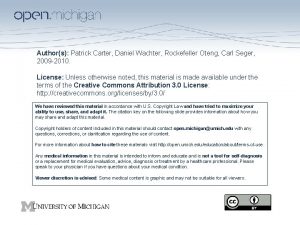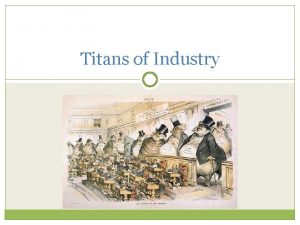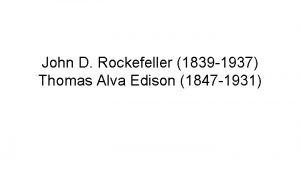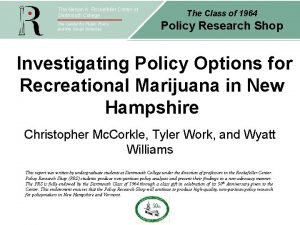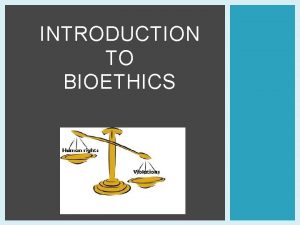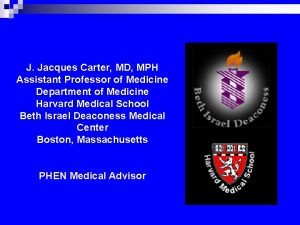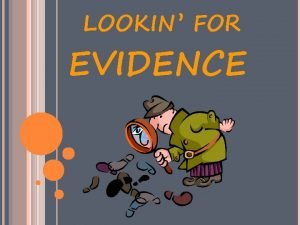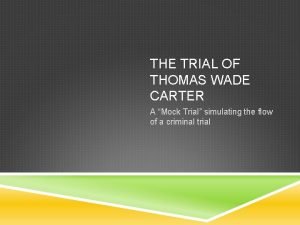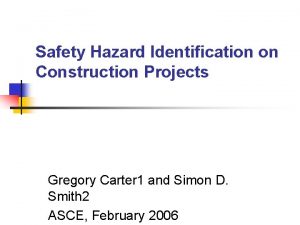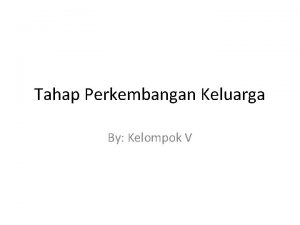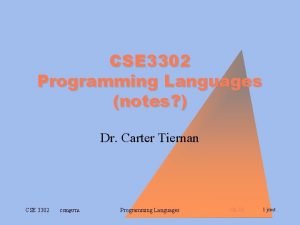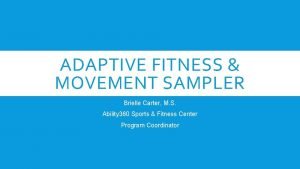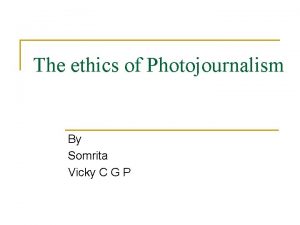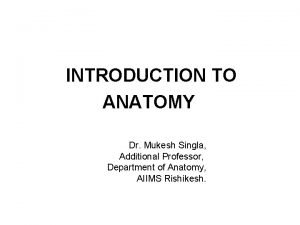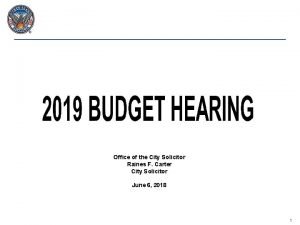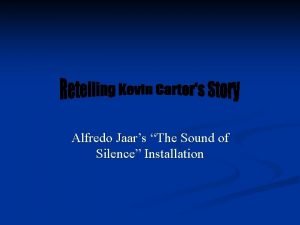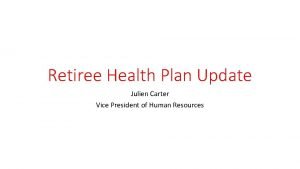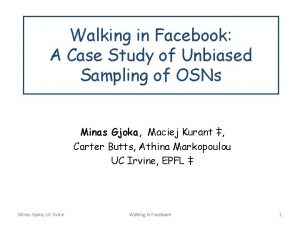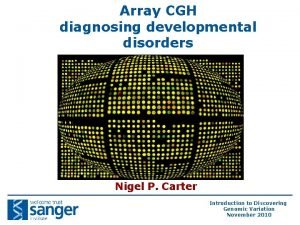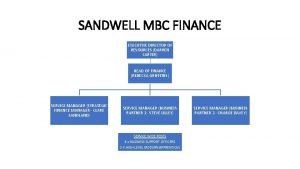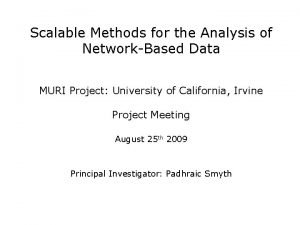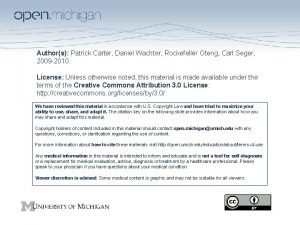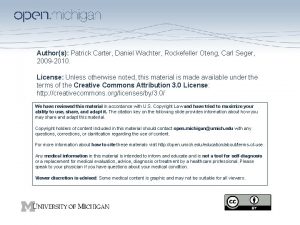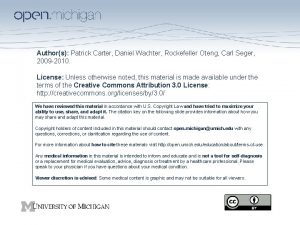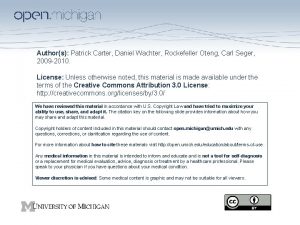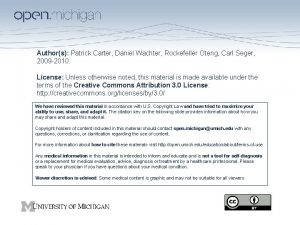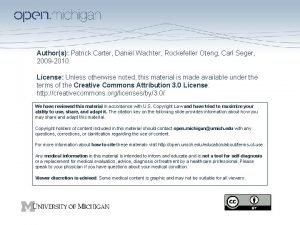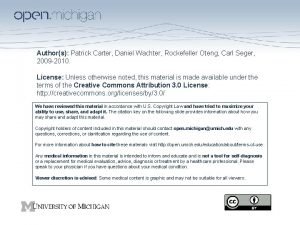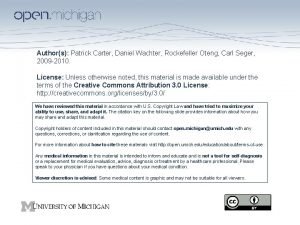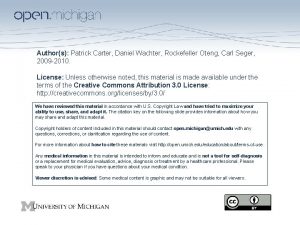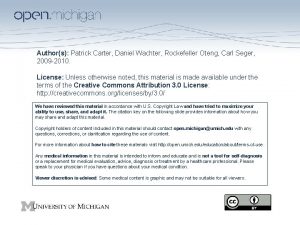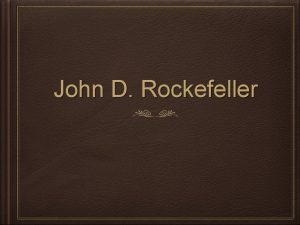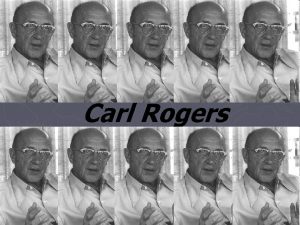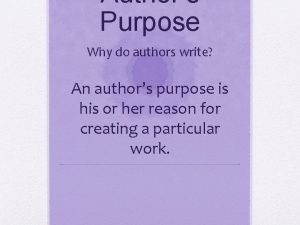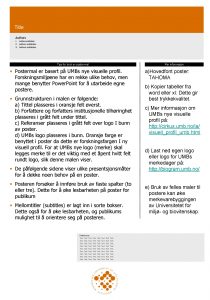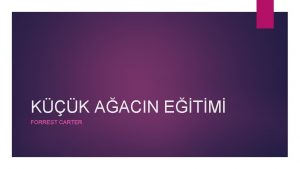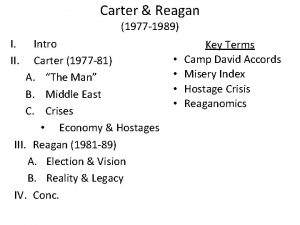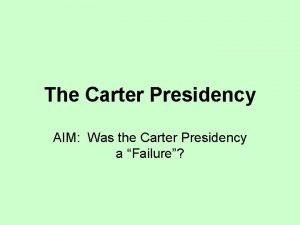Authors Patrick Carter Daniel Wachter Rockefeller Oteng Carl














































- Slides: 46

Author(s): Patrick Carter, Daniel Wachter, Rockefeller Oteng, Carl Seger, 2009 -2010. License: Unless otherwise noted, this material is made available under the terms of the Creative Commons Attribution 3. 0 License: http: //creativecommons. org/licenses/by/3. 0/ We have reviewed this material in accordance with U. S. Copyright Law and have tried to maximize your ability to use, share, and adapt it. The citation key on the following slide provides information about how you may share and adapt this material. Copyright holders of content included in this material should contact open. michigan@umich. edu with any questions, corrections, or clarification regarding the use of content. For more information about how to cite these materials visit http: //open. umich. edu/education/about/terms-of-use. Any medical information in this material is intended to inform and educate and is not a tool for self-diagnosis or a replacement for medical evaluation, advice, diagnosis or treatment by a healthcare professional. Please speak to your physician if you have questions about your medical condition. Viewer discretion is advised: Some medical content is graphic and may not be suitable for all viewers.

Citation Key for more information see: http: //open. umich. edu/wiki/Citation. Policy Use + Share + Adapt { Content the copyright holder, author, or law permits you to use, share and adapt. } Public Domain – Government: Works that are produced by the U. S. Government. (USC 17 § 105) Public Domain – Expired: Works that are no longer protected due to an expired copyright term. Public Domain – Self Dedicated: Works that a copyright holder has dedicated to the public domain. Creative Commons – Zero Waiver Creative Commons – Attribution License Creative Commons – Attribution Share Alike License Creative Commons – Attribution Noncommercial Share Alike License GNU – Free Documentation License Make Your Own Assessment { Content Open. Michigan believes can be used, shared, and adapted because it is ineligible for copyright. } Public Domain – Ineligible: Works that are ineligible for copyright protection in the U. S. (USC 17 § 102(b)) *laws in your jurisdiction may differ { Content Open. Michigan has used under a Fair Use determination. } Fair Use: Use of works that is determined to be Fair consistent with the U. S. Copyright Act. (USC 17 § 107) *laws in your jurisdiction may differ Our determination DOES NOT mean that all uses of this 3 rd-party content are Fair Uses and we DO NOT guarantee that your use of the content is Fair. To use this content you should do your own independent analysis to determine whether or not your use will be Fair.

Advanced Emergency Trauma Course Burns Presenter: Carl Seger, MD Ghana Emergency Medicine Collaborative Patrick Carter, MD ∙ Daniel Wachter, MD ∙ Rockefeller Oteng, MD ∙ Carl Seger, MD

Epidemiology of Burns n n 1 -1. 5% of population sees MD for burns/year in US 1. 25 -2. 5 million burns each year 500, 000 ED visits, 50, 000 admits, 5, 000 deaths Most burns cover less than 5 -10% of body surface area Ghana Emergency Medicine Collaborative Advanced Emergency Trauma Course

Types of Burns Thermal n Chemical n Electrical n Ghana Emergency Medicine Collaborative Advanced Emergency Trauma Course

Thermal Burns n n Contact Flame Heat Scalding Medscape Ghana Emergency Medicine Collaborative Advanced Emergency Trauma Course

Chemical Burns n n n Both acids and bases can be defined as caustics, which cause significant tissue damage on contact. ACIDS produce a coagulation necrosis by denaturing proteins, forming a coagulum (eg. eschar) that limits the penetration of the acid. BASES typically produce a more severe injury known as liquefaction necrosis Ghana Emergency Medicine Collaborative Advanced Emergency Trauma Course

Chemical Burns n Acids • Toilet bowl cleaners, drain cleaners, metal cleaners, automobile battery fluid, fertilizer manufacturing, rust removers, tire cleaners, tile cleaners, glass etching, dental work, refrigerant, and hair wave neutralizers n Bases • Drain cleaners, bleach, oven cleaners, mortar, plaster, and cement Ghana Emergency Medicine Collaborative Advanced Emergency Trauma Course

Electrical Burns n n Low-voltage • Electric burns almost exclusively involve either the hands or oral cavity. High-voltage • In burns from an electric arc, the current courses external to the body from the contact point to the ground • Electric current that passes between the power source and the anatomic point of contact (entrance wound), and between the patient (exit wound) and the grounding mechanism, causing hidden destruction of deeper tissues Ghana Emergency Medicine Collaborative Advanced Emergency Trauma Course

General Skin Anatomy and Physiology n Skin Layers • Epidermis • Dermis n Skin Function • Protection n n Pathogens Water loss • Temp regulation • Sensation • Vitamin D Synthesis National Cancer Institute, SEER Ghana Emergency Medicine Collaborative Advanced Emergency Trauma Course

Classification n Traditional Classification • 1 st degree • 2 nd degree • 3 rd degree n Current Classification • Superficial partial thickness • Deep partial thickness • Full Thickness Ghana Emergency Medicine Collaborative Advanced Emergency Trauma Course

Burn Classification K. Aainsqatsi, Wikipedia Ghana Emergency Medicine Collaborative Advanced Emergency Trauma Course

1 st Degree n n n Redness Dry skin Painful to touch Pain lasts 48 to 72 hrs Peeling skin Source Undetermined Ghana Emergency Medicine Collaborative Advanced Emergency Trauma Course

2 nd Degree; Partial Thickness n n n Involves the top layers of skin. The skin is red and blistered. Usually painful. Takes up to 3 -4 weeks to heal. May scar. Source Undetermined Ghana Emergency Medicine Collaborative Advanced Emergency Trauma Course

3 rd degree; Full thickness burns n n n Destroys all lays of skin and underlying structures. May look brown or black and tissue underneath may be white. Usually not painful. Source Undetermined Ghana Emergency Medicine Collaborative Advanced Emergency Trauma Course

Pathophysiology of Burns Cellular damage at >45° C n Dependent on temperature and duration n • Singer et al. Acad Emerg Med 2000; 7: 1 n Three zones of injury – Central zone of necrosis n Zone of stasis (at risk of necrosis) n Zone of hyperemia n • Jackson Br J Surg 1953; 40: 588 Burn Pathophysiology Ghana Emergency Medicine Collaborative Advanced Emergency Trauma Course

Pathophysiology of Burns n Thermal injury triggers intense inflammatory response • Initial release of histamine, bradykinin • Increased capillary permeability with third spacing • Progressive vascular occlusion by PMN, RBCs • Release of free radicals, proteases Ghana Emergency Medicine Collaborative Advanced Emergency Trauma Course

Clinical Evaluation n History • History of events – closed space, toxic fumes • Evaluate for inconsistencies or patterns suggesting child abuse (immersion injuries) • PMH: AMPLE, Tetanus immunization status Ghana Emergency Medicine Collaborative Advanced Emergency Trauma Course

Clinical Evaluation • Physical Exam n Assess for inhalation injury • • Signs not always present Singed nasal hair Carbonaceous sputum Cough Hoarseness Dyspnea AMS • Assess Severity of Injury Ghana Emergency Medicine Collaborative Advanced Emergency Trauma Course

Clinical Evaluation n Determine Severity of Injury • Size • Depth/Degree • Location- n Hands, face, genitals, feet, circumfrential • Rule of 9’s Ghana Emergency Medicine Collaborative Advanced Emergency Trauma Course

Rule of 9’s Burnsurgery. org Ghana Emergency Medicine Collaborative Advanced Emergency Trauma Course

Initial Burn Management n n n n ABCs Identify and treat associated injuries Remove source, protect rescue Initial cooling with cool water (not cold) Cover with dressing, leave blisters intact Brush off any metal other material Irrigation for chemical burns Ghana Emergency Medicine Collaborative Advanced Emergency Trauma Course

Acute Management n Airway Management • Secure airway early • Signs of impending airway obstruction n Hoarseness, Stridor, Facial edema • Endotracheal intubation or surgical airway if ET not possible • Give 100% O 2 for suspected smoke inhalation Ghana Emergency Medicine Collaborative Advanced Emergency Trauma Course

Chemical Burns n Brush off dry material first n Take off any clothing that can easily be removed n Flush with water for at least 20 -30 minutes Ghana Emergency Medicine Collaborative Advanced Emergency Trauma Course

Acute Management n Fluid Resuscitation • Parkland Formula • Urine Output • Pediatric Considerations Ghana Emergency Medicine Collaborative Advanced Emergency Trauma Course

Parkland Formula n n 4 x (% body surface burned) x wt in Kg This equals the amount of fluid (in ml) to replace in a 24 hr period The first half in the first 8 hrs The rest in the next 16 hrs Ghana Emergency Medicine Collaborative Advanced Emergency Trauma Course

Acute management n General Wound Care Principles • Biological Dressing • Wound Debridement Ghana Emergency Medicine Collaborative Advanced Emergency Trauma Course

Acute management n Topical Agents • Silvadine cream • Covering the wound with clean linens n Analgesia • Often very painful and require large amount of pain medication Ghana Emergency Medicine Collaborative Advanced Emergency Trauma Course

Do’s and Don’ts of Burn Care n Do’s n • Brush off dry chemical while in a protective suit • Flush with cool water • Cover wound with dry dressing • Keep victim comfortable Don’ts • Apply ice • Touch the burn • Remove pieces of cloth from burned area • Clean severe burns • Break blisters • Use ointment on severe burns Ghana Emergency Medicine Collaborative Advanced Emergency Trauma Course

Acute management n Escharotomy • Deep circumferential burns over neck, chest limbs • Compromised ABC’s • May be life or limb threatening • Incision of eschar to sub Q fat • Avoid major vessels and nerves • Anesthetics usually not required Ghana Emergency Medicine Collaborative Advanced Emergency Trauma Course

Escharotomy Medscape Ghana Emergency Medicine Collaborative Advanced Emergency Trauma Course

Acute management n Inhalational Injuries • General Evaluation and Management • Carbon Monoxide Ghana Emergency Medicine Collaborative Advanced Emergency Trauma Course

Inhalational Injuries n n n Responsible for most deaths Evolution may require several days Exposure of airways and lungs to toxic chemicals Tracheobronchitis Airway obstruction Pulmonary edema within 2 -3 days Ghana Emergency Medicine Collaborative Advanced Emergency Trauma Course

Inhalation Injury n Carbon Monoxide • Has higher affinity for hemoglobin than O 2. • CO poisoning can lead to AMS, myocardial ischemia, and severe long term neurologic sequelae • O 2 in higher concentrations accelerates CO elimination • Can also treat with amyl nitrate, sodium nitrite, sodium thiosulfate Ghana Emergency Medicine Collaborative Advanced Emergency Trauma Course

Complications of Burn Care § Infection § Airway Considerations § Circumferential Burns Ghana Emergency Medicine Collaborative Advanced Emergency Trauma Course

Indications for Admission n n n Adults > 15% 2° Degree Burns Children > 10% 2° Degree Burns 3° burns > 2% Face, hands, feet, perineum Serious underlying diseases Social considerations Ghana Emergency Medicine Collaborative Advanced Emergency Trauma Course

When does Cold Injury Occur? n The Factors that contribute to Cold Injury • Temperature • Duration of exposure • Immobilization • Moisture • Vascular disease • Open wounds Ghana Emergency Medicine Collaborative Advanced Emergency Trauma Course

Recognize local cold injuries n n Frostnip- Mild form, does not result in tissue destruction, very painful Frostbite- intracellular ice crystals, can get reperfusion injury, Classified based off of depth Medscape Ghana Emergency Medicine Collaborative Advanced Emergency Trauma Course

Frostbite Medscape Ghana Emergency Medicine Collaborative Advanced Emergency Trauma Course

Treating cold injuries n n n n Do not delay Remove clothing Warmed blankets Rewarm frozen part Preserve damaged tissue Prevent infection Elevated exposed part Analgesics, tetanus, and antibiotics Ghana Emergency Medicine Collaborative Advanced Emergency Trauma Course

Recognize hypothermia n n n Rapid or slow drop in core temperature to < 35 degrees C Elderly and children at greater risk Low-range thermometer required Ghana Emergency Medicine Collaborative Advanced Emergency Trauma Course

Hypothermia clinical signs n n n Temperature <35 degrees C Depressed Level of consciousness Gray, cyanotic Variable vital signs Absence of cardiorespiratory activity Ghana Emergency Medicine Collaborative Advanced Emergency Trauma Course

Treating Hypothermia n n ABCDE’s Rewarm Assess for associated disorders Blood analyses, including K+ and C++ Ghana Emergency Medicine Collaborative Advanced Emergency Trauma Course

Treating hypothermia n n n Passive external rewarming: Warm enviroment, blankets, IV fluids Active core rewarming: surgical rewarming techniques Not dead until warm and dead Ghana Emergency Medicine Collaborative Advanced Emergency Trauma Course

Questions? Dkscully (flickr)

References n n Schwartz, L. , Balakrishnan, C. Thermal Burns. in Emergency Medicine: A Comprehensive Guide. Tintinalli, Editor. 2004, Mc. Graw. Hill. p. 1220 -1226. Harchelroad, F. , Rottinghaus, D. Chemical Burns, in Emergency Medicine: A Comprehensive Guide. Tintinalli, Editor. 2004, Mc. Graw. Hill. p. 1226 -1231 Fish, R. Electrical Injuries and Lightning Injuries, in Emergency Medicine: A Comprehensive Guide. Tintinalli, Editor. 2004, Mc. Graw. Hill. p. 1231 -1238 American College of Surgeons. Injuries due to burns and cold, in Advanced Trauma Life Support for Doctors 7 th edition. 2004. p. 231241. Ghana Emergency Medicine Collaborative Advanced Emergency Trauma Course
 Patrick carter md
Patrick carter md Dorien de wachter
Dorien de wachter Richard wachter
Richard wachter Nasser and prokofiev rockefeller
Nasser and prokofiev rockefeller Ecetp.pdp.albany.edu.elearning
Ecetp.pdp.albany.edu.elearning Carnegie and rockefeller venn diagram
Carnegie and rockefeller venn diagram Jp morgan vertical integration
Jp morgan vertical integration Alva rockefeller
Alva rockefeller David rockefeller memoirs page 405
David rockefeller memoirs page 405 Jp morgan horizontal integration
Jp morgan horizontal integration Rockefeller center dartmouth
Rockefeller center dartmouth John d. rockefeller iii
John d. rockefeller iii Rockefeller center gingerbread house
Rockefeller center gingerbread house John d. rockefeller iii
John d. rockefeller iii Oldest rockefeller alive
Oldest rockefeller alive Nixon ford carter reagan
Nixon ford carter reagan Jacque carter
Jacque carter Bob carter principal
Bob carter principal Zinn chapter 21 summary
Zinn chapter 21 summary Thomas wade evans
Thomas wade evans Morse v frederick summary
Morse v frederick summary Uuuu0
Uuuu0 Carter jenkins daughter
Carter jenkins daughter Gregory carter
Gregory carter Dr fernando mora-mclaughlin
Dr fernando mora-mclaughlin Jimmy carter
Jimmy carter My ucl careers
My ucl careers Tahap perkembangan keluarga menurut carter
Tahap perkembangan keluarga menurut carter Carter tiernan
Carter tiernan Connie carter
Connie carter Brielle carter
Brielle carter Photojournalism ethics cases
Photojournalism ethics cases Presidential webquest
Presidential webquest Mukesh singla
Mukesh singla City organizational chart
City organizational chart The sound of silence alfredo jaar
The sound of silence alfredo jaar Julien carter
Julien carter Jackie carter porn
Jackie carter porn Carter butts uci
Carter butts uci 882
882 Nigel p carter
Nigel p carter Clare sandland
Clare sandland Carter review of initial teacher training
Carter review of initial teacher training Jennifer carter oxford
Jennifer carter oxford Carter butts uci
Carter butts uci Gravis carter
Gravis carter Kevin carter akbaba
Kevin carter akbaba
